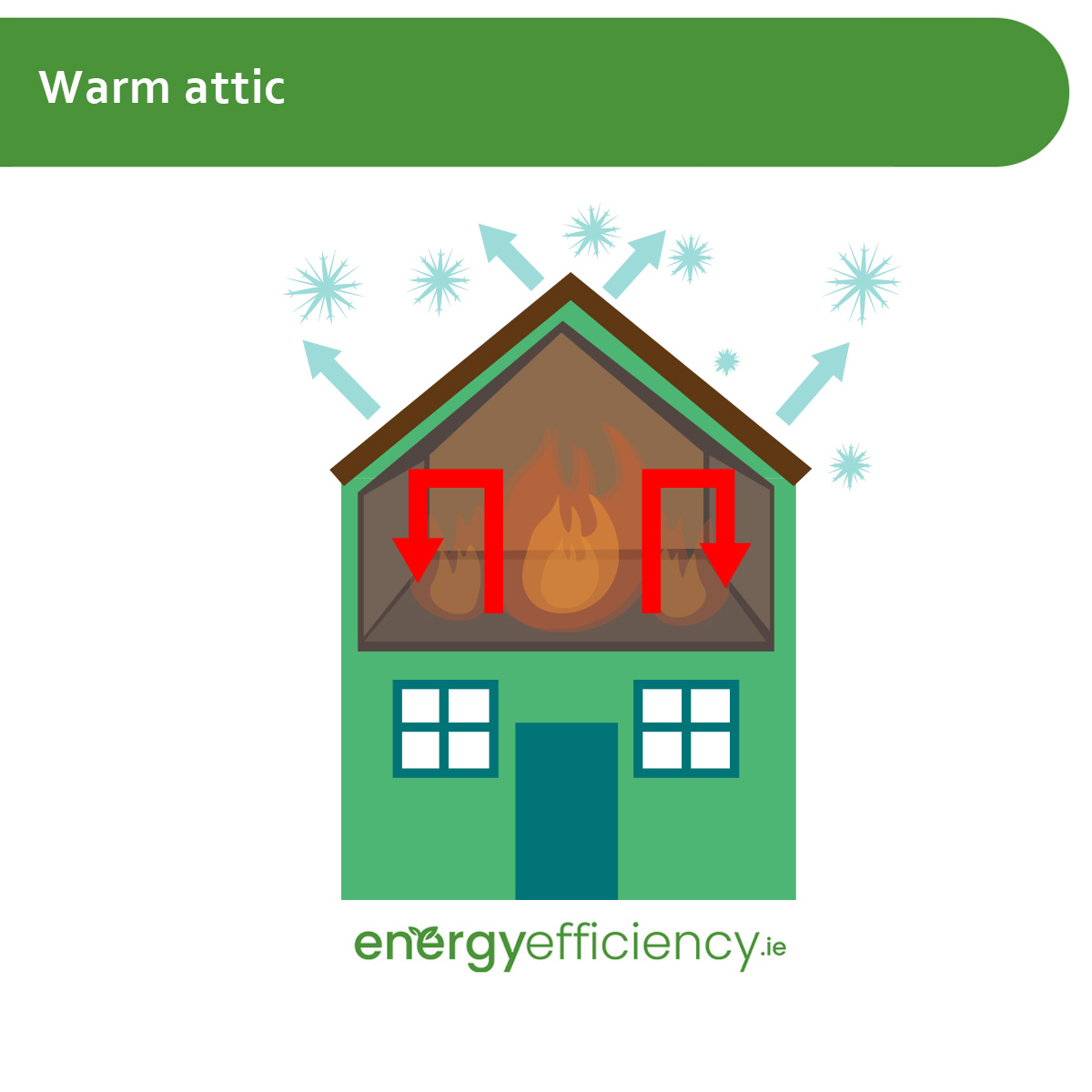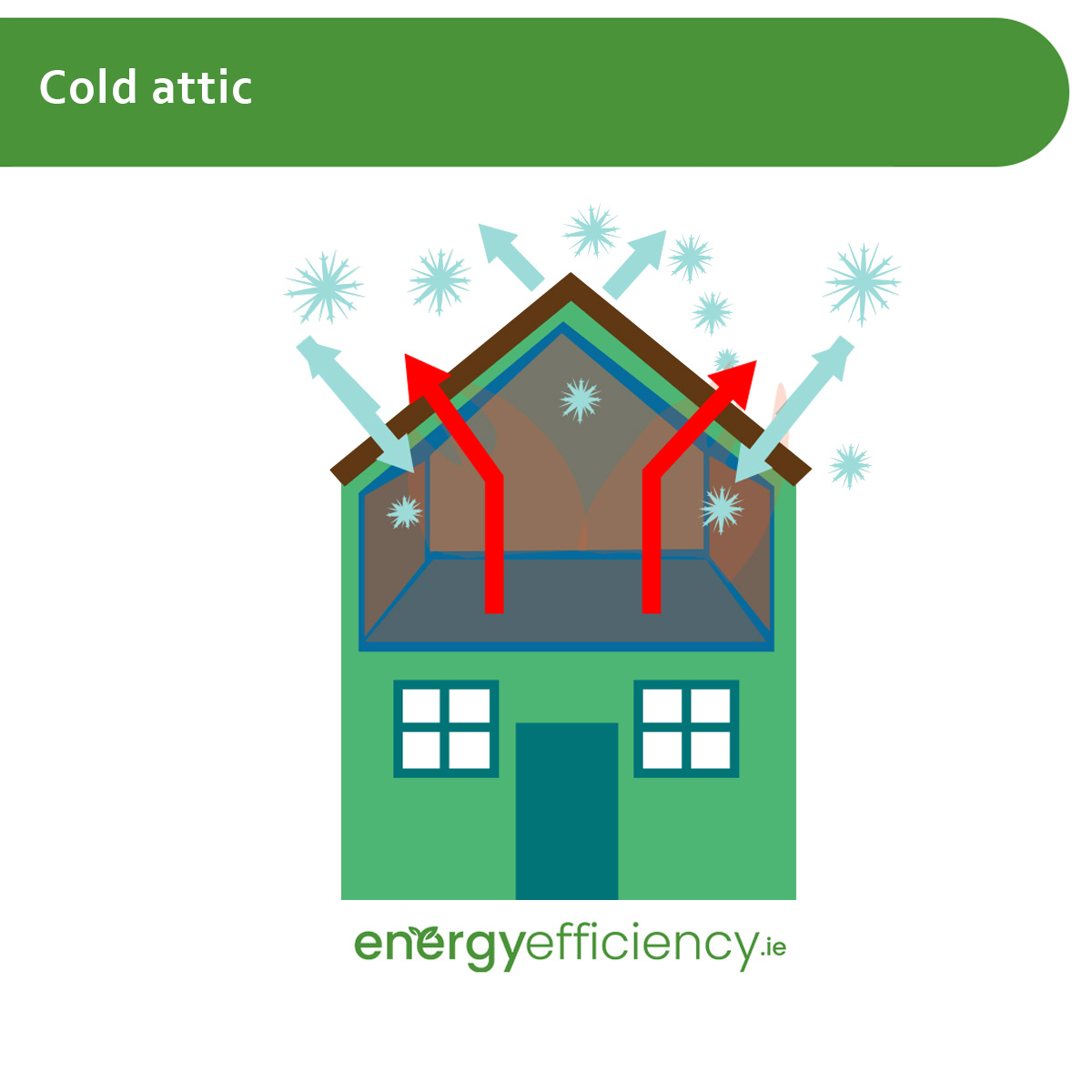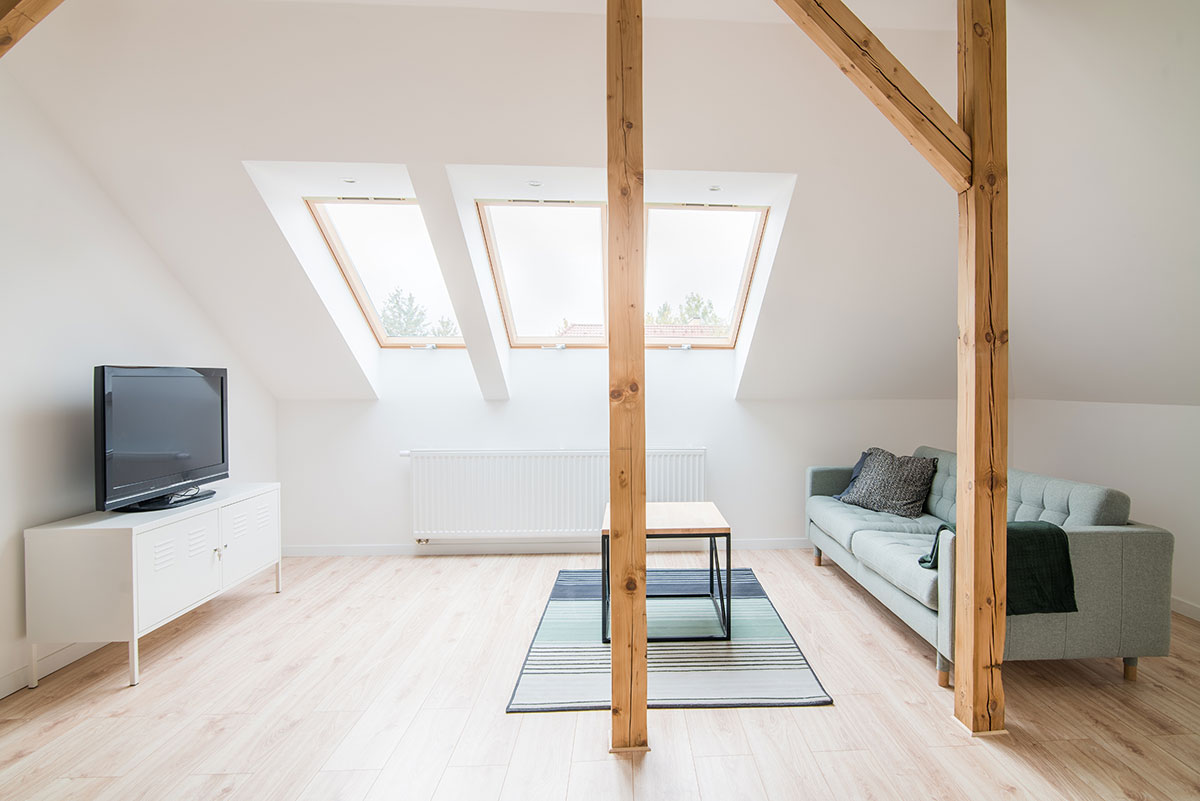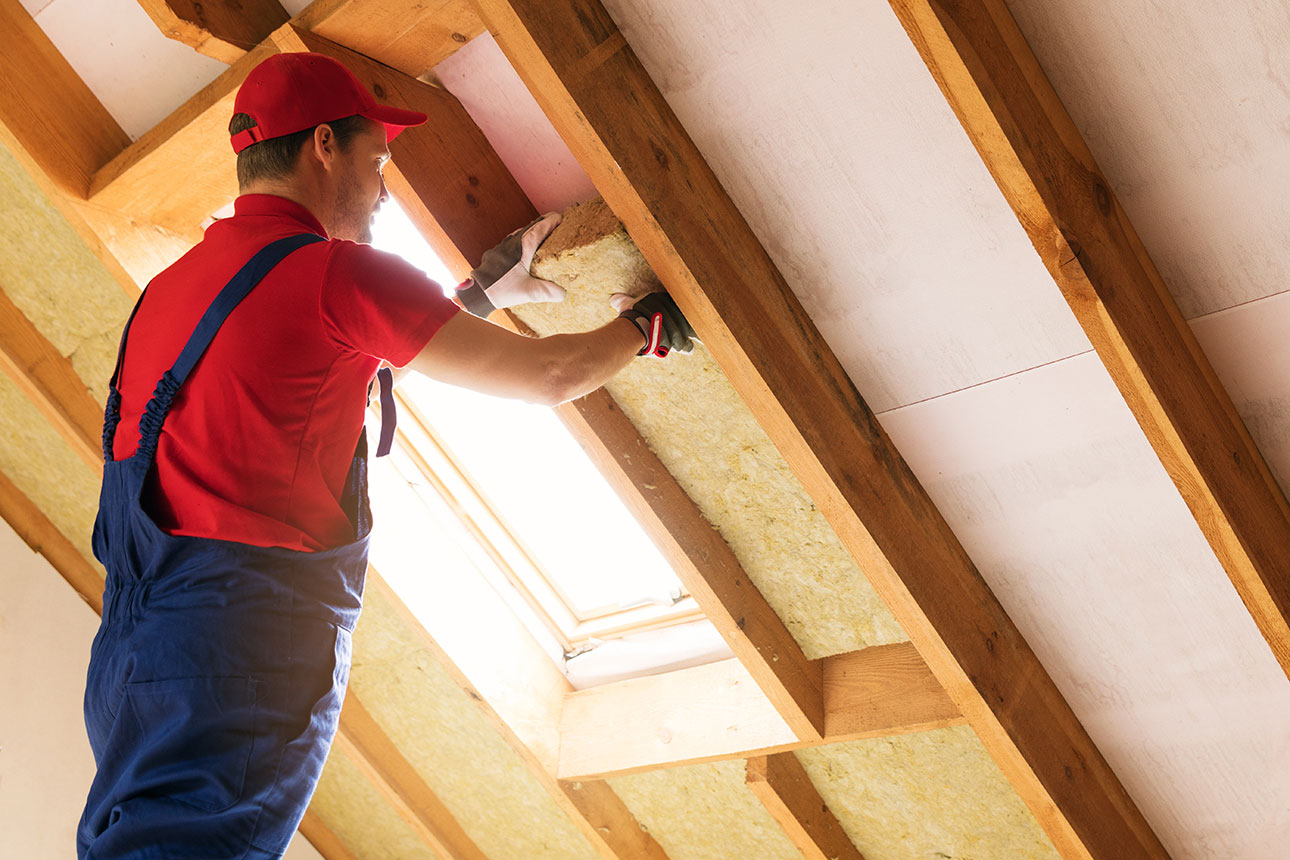Warm Attic v Cold Attic – Different Ways to Insulate an Attic

Written by: Briain Kelly
Published: June 8, 2024
Last updated: October 28, 2025
Reading time: 4 mins
Attic insulation is a relatively easy and inexpensive way to make your home more comfortable and energy efficient. There are two main ways to insulate an attic, at the ceiling level or the rafter level.
Choosing between the two will affect what insulation material is used, the installation process, and whether you are left with a warm or cold attic at the end of the process.
Whether you wish for a warm or cold attic is important for how the space will be used in the future, and what are the specific goals of the home insulation retrofit.

Warm Attic
A warm attic is achieved by insulating at the rafter level, which is typically done using spray foam insulation between the rafter joists, or with rigid polystyrene boards.
This will create an airtight seal around the entire attic space, ensuring that all heat generated within the home is trapped inside, and providing protection against the elements.
As the entire attic space is being heated, you don’t have to worry as much about the potential freezing of pipes or the cold water tank.
When insulating at the rafter level, the exact location of the insulation can also determine if it will result in a warm roof or a cold roof.
A Warm Roof occurs when the insulation is installed above and between the rafters, keeping them warm.
A Cold Roof is when insulation is installed between and below rafters, leaving them exposed to the cold.

Cold Attic
With a cold attic, loft insulation is applied at the ceiling level, laid between and over the ceiling joists using solid boards of insulation or mineral wool rolls.
This creates a seal of attic insulation between the attic living space of the building below, blocking any heat from escaping into the attic itself.
In a cold attic system, insulation should also be applied to a cold water tank if present, or any water pipes. They will be considerably more vulnerable to freezing in colder temperatures.

What Will the Attic Be Used For
Where you choose to insulate the attic will create two very different environments, and anyone getting insulation installed should consider what they are using the space for and what they might use it for in the future.
Insulating at the rafter level will create a warm space, which is ideal if it is being converted into a living space, or might be converted at a later date.
If the attic is not going to be used as a living space, then insulating at the ceiling level might be a simpler solution. This can be more efficient if done with enough insulation, as heat is kept within the living space of the building.
Installing Attic Insulation

Cold Attic Insulation
Attic insulation installed at the ceiling level, which creates a cold attic, will involve mineral wool being laid between and on top of the ceiling joists.
The first layer is placed between each of the joists. Homes may already have some loft insulation present in their attic, likely fibreglass rolls. This can be left in place and new insulation laid on top, or replaced entirely with new mineral wool insulation.
The first layer of insulation should rise to the layer of the joists, and a second should be laid perpendicularly on top of that to cover the joists and prevent thermal bridging.
Ideally, you want to reach a depth of 300mm of mineral wool for the best thermal performance.
If the attic is to be used for storage, or if you need to reach the cold water tank, further insulating floorboards can be laid on top of the insulation.
Warm Attic Insulation
Warm Attic Insulation involves the installation of insulation in between the rafters of a pitched roof. This is done either with rigid boards or batts of insulation fixed in place, or with the use of spray foam insulation.
One advantage of warm attic insulation is that it can achieve high thermal performance without sacrificing as much attic space as loft roll insulation. Expanding spray foam insulation has a very high R-value for a lower thickness than is achieved with mineral wool insulation.
When insulating at the rafter level, it is important that a breathable layer of ventilation space is kept between the insulation and the roof itself in order to prevent damp or mould from developing.
If there are areas such as gable walls or chimneys in the attic, they must also be insulated if creating a warm attic space, or else they will act as a thermal bridge allowing heat to escape.
A breathable vapour membrane may also have to be installed on the warm side of the insulation. In some cases, plasterboard can also be used to provide an attractive finish at the end.
Warm Vs Cold Attic – Energy Efficiency
A cold attic, using mineral wool to insulate the loft, is more energy-efficient for home heating. This is simply because there is a smaller space within the home to be heated.
Having insulation at the rafter level will result in a greater envelope of air within the insulated area, and a larger surface area from which heat can escape.
Areas such as gables or chimneys also need to be considered as potential thermal bridges which need to be insulated in order to stop heat from being lost with attic insulation.
Warm Vs Cold Attic – Cost Effectiveness
Determining which is the most cost effective method of attic insulation depends on a variety of factors such as its intended use and heating costs. But there are also the installation costs to take into consideration.
A warm attic will typically make use of spray foam insulation between the rafters. This is more expensive than mineral wool rolls which are laid down at the loft ceiling level.
There may also be other costs associated with each different type of attic insulation which will vary depending on the home and the climate.
Warm Attic
- Spray Foam Insulation between rafters
- Vapour Control Membrane
- Plasterboard covering
- Chimney/Gable Insulation
Cold Attic
- Water Tank/Pipework Insulation
- Insulated Floorboards
Get in Touch
Get in Touch with us today for a free quote and to hear more about how home insulation can save you money and create a more comfortable living space.
Warm Attic v Cold Attic – Different Ways to Insulate an Attic
Published: June 8, 2024
Last updated: October 28, 2025

Written by: Briain Kelly
Reading time: 4mins
Attic insulation is a relatively easy and inexpensive way to make your home more comfortable and energy efficient. There are two main ways to insulate an attic, at the ceiling level or the rafter level.
Choosing between the two will affect what insulation material is used, the installation process, and whether you are left with a warm or cold attic at the end of the process.
Whether you wish for a warm or cold attic is important for how the space will be used in the future, and what are the specific goals of the home insulation retrofit.

Warm Attic
A warm attic is achieved by insulating at the rafter level, which is typically done using spray foam insulation between the rafter joists, or with rigid polystyrene boards.
This will create an airtight seal around the entire attic space, ensuring that all heat generated within the home is trapped inside, and providing protection against the elements.
As the entire attic space is being heated, you don’t have to worry as much about the potential freezing of pipes or the cold water tank.
When insulating at the rafter level, the exact location of the insulation can also determine if it will result in a warm roof or a cold roof.
A Warm Roof occurs when the insulation is installed above and between the rafters, keeping them warm.
A Cold Roof is when insulation is installed between and below rafters, leaving them exposed to the cold.

Cold Attic
With a cold attic, loft insulation is applied at the ceiling level, laid between and over the ceiling joists using solid boards of insulation or mineral wool rolls.
This creates a seal of attic insulation between the attic living space of the building below, blocking any heat from escaping into the attic itself.
In a cold attic system, insulation should also be applied to a cold water tank if present, or any water pipes. They will be considerably more vulnerable to freezing in colder temperatures.

What Will the Attic Be Used For
Where you choose to insulate the attic will create two very different environments, and anyone getting insulation installed should consider what they are using the space for and what they might use it for in the future.
Insulating at the rafter level will create a warm space, which is ideal if it is being converted into a living space, or might be converted at a later date.
If the attic is not going to be used as a living space, then insulating at the ceiling level might be a simpler solution. This can be more efficient if done with enough insulation, as heat is kept within the living space of the building.
Installing Attic Insulation

Cold Attic Insulation
Attic insulation installed at the ceiling level, which creates a cold attic, will involve mineral wool being laid between and on top of the ceiling joists.
The first layer is placed between each of the joists. Homes may already have some loft insulation present in their attic, likely fibreglass rolls. This can be left in place and new insulation laid on top, or replaced entirely with new mineral wool insulation.
The first layer of insulation should rise to the layer of the joists, and a second should be laid perpendicularly on top of that to cover the joists and prevent thermal bridging.
Ideally, you want to reach a depth of 300mm of mineral wool for the best thermal performance.
If the attic is to be used for storage, or if you need to reach the cold water tank, further insulating floorboards can be laid on top of the insulation.
Warm Attic Insulation
Warm Attic Insulation involves the installation of insulation in between the rafters of a pitched roof. This is done either with rigid boards or batts of insulation fixed in place, or with the use of spray foam insulation.
One advantage of warm attic insulation is that it can achieve high thermal performance without sacrificing as much attic space as loft roll insulation. Expanding spray foam insulation has a very high R-value for a lower thickness than is achieved with mineral wool insulation.
When insulating at the rafter level, it is important that a breathable layer of ventilation space is kept between the insulation and the roof itself in order to prevent damp or mould from developing.
If there are areas such as gable walls or chimneys in the attic, they must also be insulated if creating a warm attic space, or else they will act as a thermal bridge allowing heat to escape.
A breathable vapour membrane may also have to be installed on the warm side of the insulation. In some cases, plasterboard can also be used to provide an attractive finish at the end.
Warm Vs Cold Attic – Energy Efficiency
A cold attic, using mineral wool to insulate the loft, is more energy-efficient for home heating. This is simply because there is a smaller space within the home to be heated.
Having insulation at the rafter level will result in a greater envelope of air within the insulated area, and a larger surface area from which heat can escape.
Areas such as gables or chimneys also need to be considered as potential thermal bridges which need to be insulated in order to stop heat from being lost with attic insulation.
Warm Vs Cold Attic – Cost Effectiveness
Determining which is the most cost effective method of attic insulation depends on a variety of factors such as its intended use and heating costs. But there are also the installation costs to take into consideration.
A warm attic will typically make use of spray foam insulation between the rafters. This is more expensive than mineral wool rolls which are laid down at the loft ceiling level.
There may also be other costs associated with each different type of attic insulation which will vary depending on the home and the climate.
Warm Attic
- Spray Foam Insulation between rafters
- Vapour Control Membrane
- Plasterboard covering
- Chimney/Gable Insulation
Cold Attic
- Water Tank/Pipework Insulation
- Insulated Floorboards
Get in Touch
Get in Touch with us today for a free quote and to hear more about how home insulation can save you money and create a more comfortable living space.
Solar Energy Saves Households Thousands in Electricity Costs
Take our 2-minute questionnaire and find affordable solar options to suit your budget and lifestyle.


